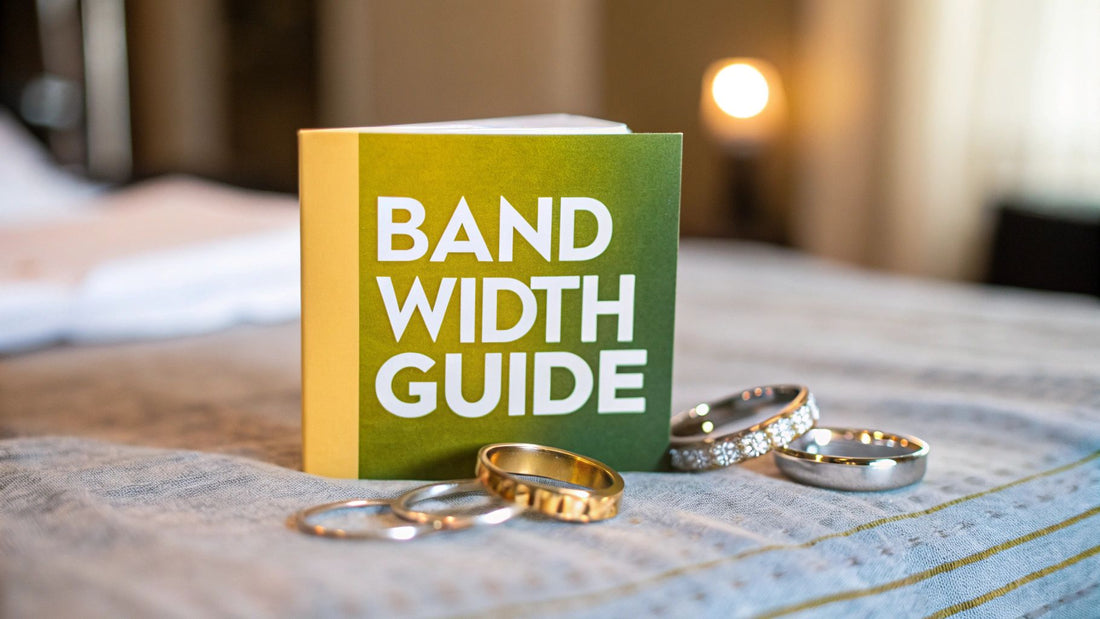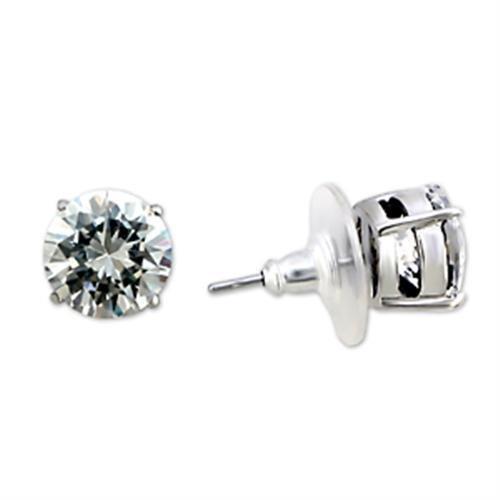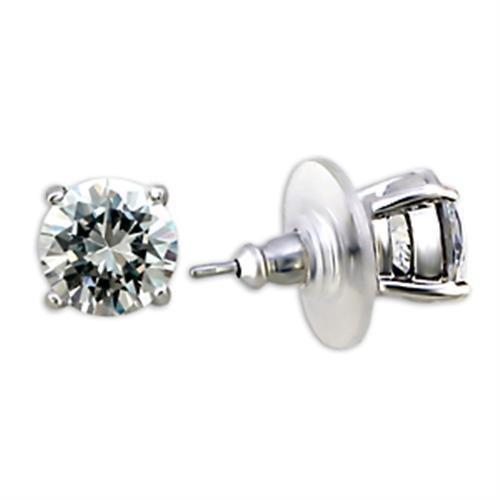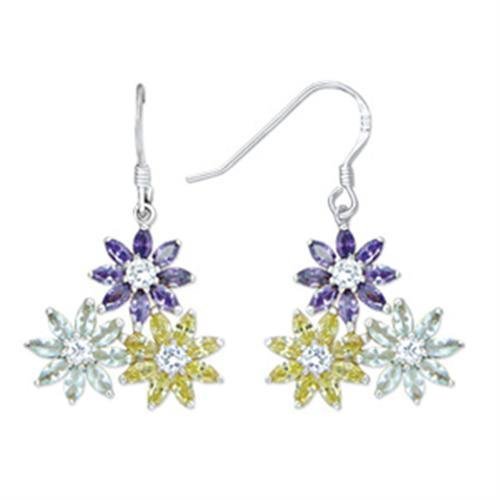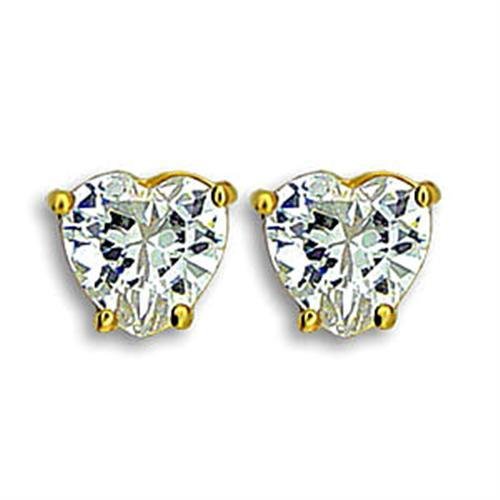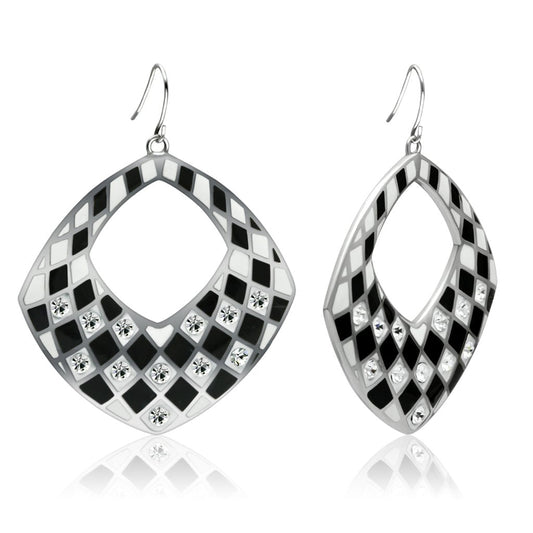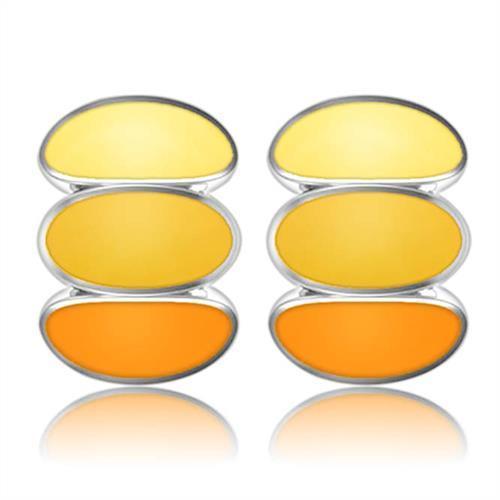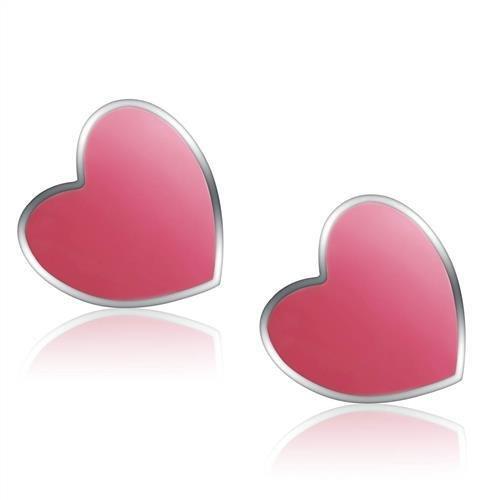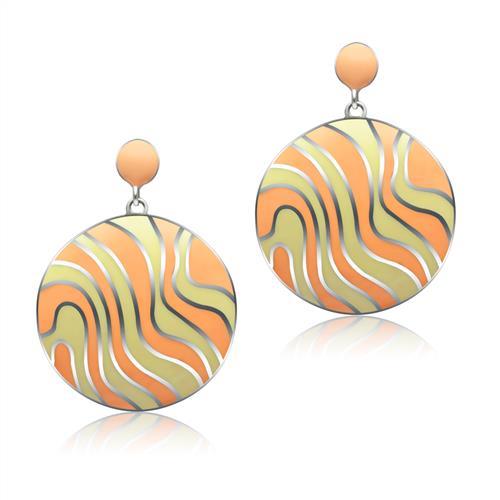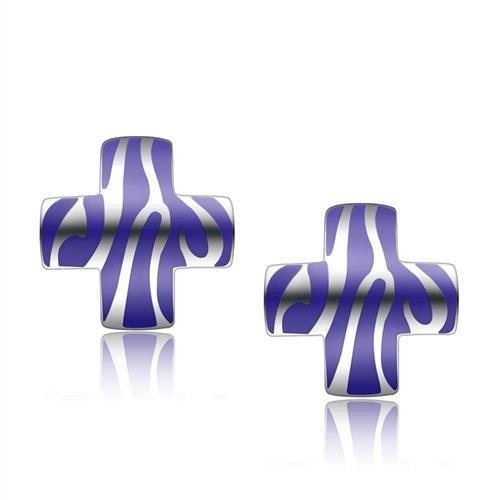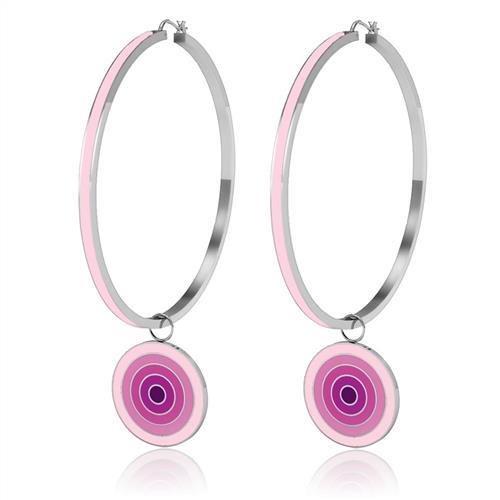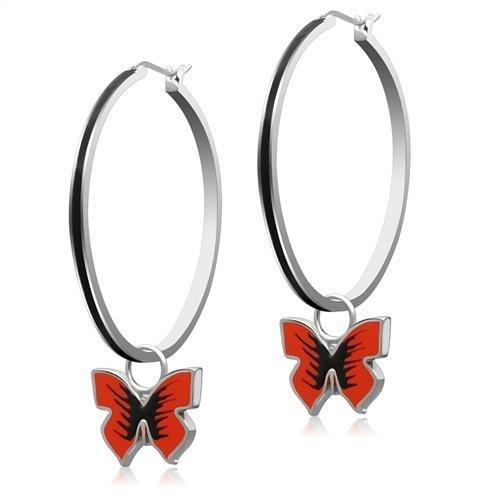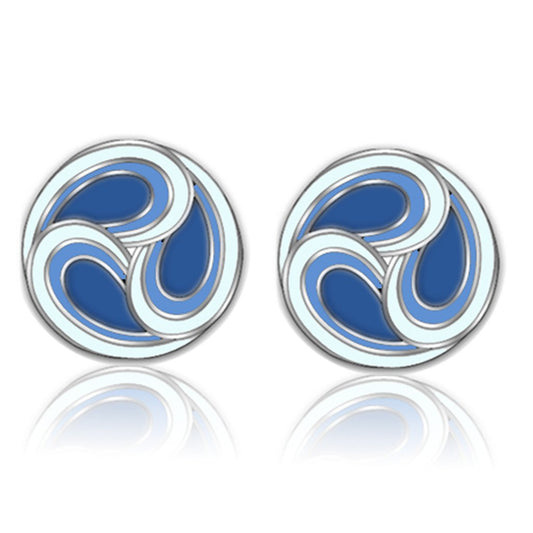Picking out the right wedding band is about more than just the metal and style. The width of the band is a surprisingly critical detail that shapes its entire look and feel on your hand. This guide provides practical, straightforward advice to help you understand how a few millimeters can transform a ring from delicate and understated to bold and commanding.
Getting this choice right is the key to finding a ring you'll love for a lifetime.
Why Wedding Band Width Matters
Imagine the width of your wedding band is like the frame on a masterpiece. A thin, simple frame gives art a modern, minimalist vibe. A thick, ornate one adds presence and commands attention. The same principle applies to your ring—its width defines its character and how it complements your hand.
The difference between a sleek 2mm band and a substantial 8mm one is night and day. It changes not only the ring's visual weight but also how it feels as you go about your day. This seemingly small choice impacts comfort, long-term durability, and how well it pairs with an engagement ring.
Key Factors Influenced by Width
So, what exactly does the width affect? Understanding how width connects to these factors is the first step toward making a choice you feel great about.
- Overall Style: Do you prefer a modern, delicate look or a strong, traditional statement? Narrow bands often feel contemporary, while wider bands project confidence.
- Comfort and Feel: The more surface area the ring covers, the more you'll notice it. If you're active or work with your hands, a comfortable width is non-negotiable.
- Proportion to Hand Size: The goal is always balance. A width that looks stunning on a slender hand might get lost on a larger one, and a wide band can sometimes overwhelm smaller fingers.
- Durability: As a general rule, a thicker and wider band offers more structural integrity. This means it's better equipped to withstand the bumps and scrapes of daily life over decades of wear.
A wedding band's width isn’t just a measurement; it's a statement of personal style. It’s the foundation that determines whether your ring whispers elegance or projects confidence.
To help you picture these differences, we've put together a quick reference for common wedding band widths and the styles they typically suit.
Wedding Band Width At a Glance
This table breaks down the most common widths to give you a quick visual feel for what might work best for you.
| Width (mm) | Common Style | Best Suited For | Visual Feel |
|---|---|---|---|
| 2mm - 3mm | Dainty & Modern | Slender fingers, stacking with engagement rings. | Understated, elegant, and minimalist. |
| 4mm - 6mm | Classic & Versatile | Most hand sizes, a popular balanced choice. | Timeless, substantial, and classic. |
| 7mm - 8mm+ | Bold & Statement | Larger hands or those wanting a prominent look. | Confident, commanding, and noticeable. |
Ultimately, this is just a starting point. The best width is the one that feels right on your hand and fits seamlessly into your life.
Matching Band Width to Your Hand Shape
A truly great wedding band doesn't just fit your finger; it complements your entire hand. The real secret to finding that perfect, harmonious look is understanding proportion. Think of it like a well-fitted suit—the right ring width highlights your best features and creates a sense of natural, effortless balance.
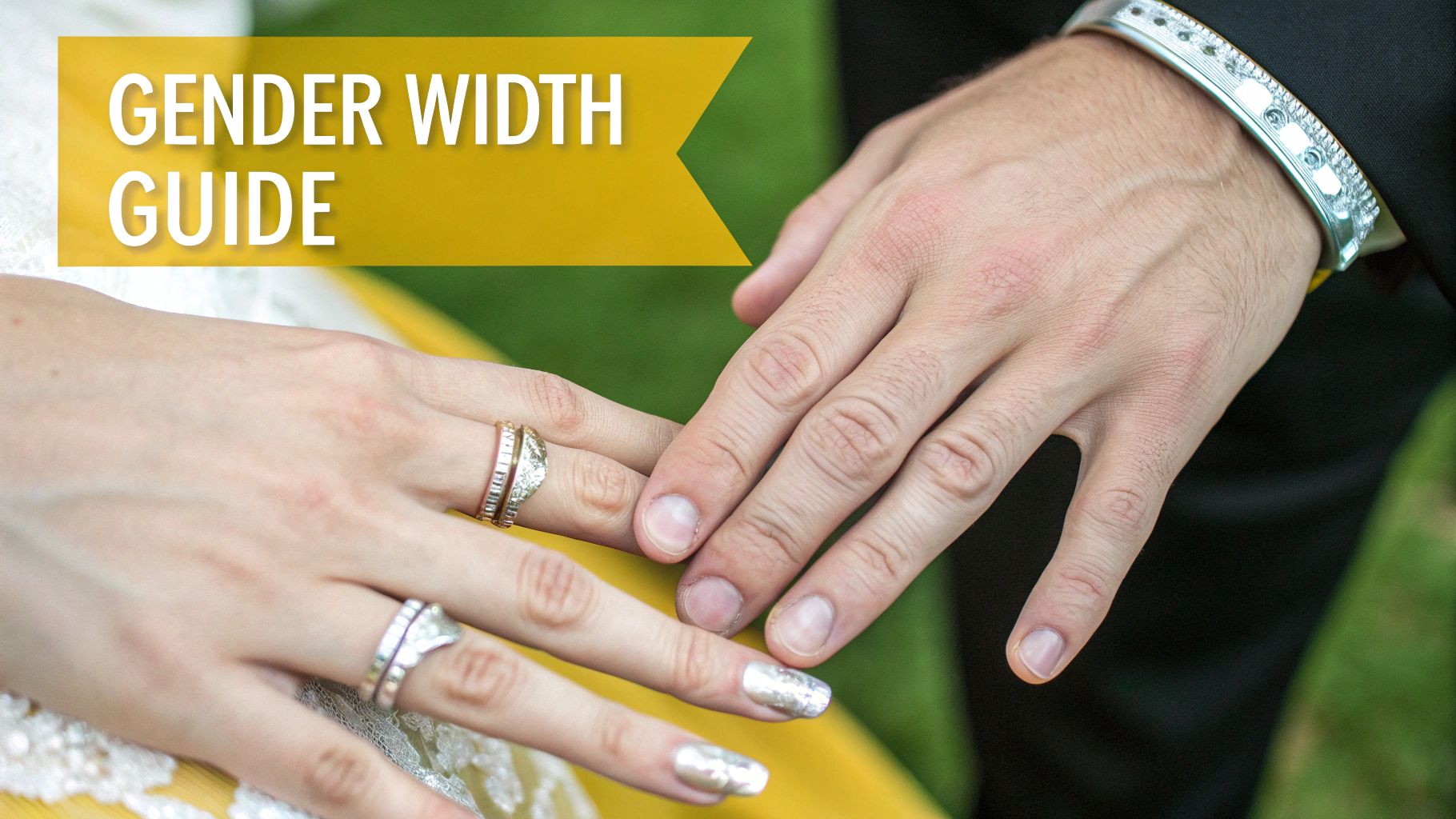
This part of the process is all about matching the frame to the painting. Your hand is the canvas, and the ring is the frame meant to enhance it, not overpower it. The goal here is to land on a width that feels like it was made just for you.
For Slender or Long Fingers
If you have long, slender fingers, you're in luck—you have incredible versatility. You can pull off almost any width, but certain styles will create a particularly elegant effect.
- Delicate Bands (2mm-4mm): These narrower widths are fantastic for accentuating the length of your fingers without overwhelming them. A 2.5mm band is a very popular choice for women, as it often lines up perfectly with the width of an engagement ring, creating a seamless and graceful stack. Our Dainty Classic Wedding Band is a perfect example of this timeless look.
- Mid-Width Bands (4mm-5mm): A slightly wider band can also look stunning. A 4mm or 5mm ring strikes a beautiful balance, offering more substance while still feeling elegant and refined.
For Broader Hands or Shorter Fingers
For those with larger hands, wider knuckles, or shorter fingers, choosing the right width is all about creating a powerful, balanced visual. A band that's too narrow can easily look out of proportion, while the right width brings a sense of presence.
A wider band, typically 6mm and up, feels more substantial and looks more proportionate on a larger hand. For men, a 6mm or 7mm width is a classic choice that has a visible presence without feeling overly bulky. If you want to make a bolder statement, an 8mm band will feel commanding and intentional. Our Bold Comfort Fit Band is designed to provide this presence without sacrificing wearability.
Here's a little secret: the right width can even create an optical illusion. A slightly tapered band can make fingers appear longer, while a uniform, wide band adds a sense of strength and stability to your hand's appearance.
Practical Tips for Finding Your Match
Before you make a final decision, getting an accurate measurement is crucial. Your finger size can fluctuate with temperature and the time of day. For the most reliable reading, measure your finger in the evening when it’s likely at its largest.
And don't forget to consider your knuckles. If your knuckle is significantly larger than the base of your finger, you’ll need a size that can slide over it comfortably. This is where trying on different widths becomes absolutely essential to finding what feels right for all-day wear.
Connecting Ring Width to Your Lifestyle
Your wedding band isn't just a piece of jewelry; it's a part of your daily life. The right one should feel like it belongs, blending perfectly with your personal style and everything you do, day in and day out. This is where we connect the dots between band width and your unique lifestyle.

First, think about your personal aesthetic. Are you a minimalist at heart, always drawn to clean, simple lines? If so, a slender band between 2mm and 4mm might be your perfect match. It offers an understated elegance that whispers its presence rather than shouts.
On the flip side, if your style is bold and you love making a statement, a wider band of 7mm or more will deliver that powerful look. It’s a confident choice that has no problem standing on its own.
Practicality in Your Daily Routine
Beyond how it looks, it has to feel right. Your daily routine is a huge factor in choosing a width that’s comfortable and durable.
For anyone with an active lifestyle or a hands-on job—think artists, mechanics, or healthcare professionals—a wider band is a smart choice. Here’s why:
- Increased Durability: A wider, thicker ring is simply stronger. It has more structural integrity, making it more resistant to bending or damage from daily wear and tear.
- Peace of Mind: Knowing your ring is sturdy gives you one less thing to worry about, whether you're at the gym or on the job.
If you spend most of your day typing or working on detailed tasks, a slimmer profile might be more comfortable. A narrower band is less likely to feel clunky or get in the way.
Creating the Perfect Wedding Set
For many, the wedding band is destined to sit right next to an engagement ring, creating a set that tells a complete story. The width you choose plays a massive role in making sure that pairing looks balanced and beautiful.
A common approach is to match the width of the wedding band to the engagement ring band, or choose one that is slightly narrower. This allows the engagement ring to remain the focal point while the wedding band provides a harmonious complement.
However, there are no hard and fast rules. Creating a stack with different widths and textures can give you a beautifully unique and personal look. The best way to know what you'll love is to experiment. If you need some inspiration, our guide on rings for stacking is packed with creative ideas for building your perfect set.
The choice of width is deeply personal and is influenced by style, culture, and even the material you choose. This is especially true in the men's wedding band market, which was valued at USD 1.05 billion in the U.S. in 2022 and continues to grow. With constant innovation, there are more options for customization than ever before.
A Visual Guide to Common Ring Widths
Reading numbers on a screen is one thing, but truly picturing how a wedding band will look and feel on your finger is something else entirely. It’s a bit like choosing the right tie—a skinny one creates a modern vibe, while a wider one feels more traditional and bold. Each width has its own personality.
Slender Bands: The Delicate Choice (2mm-3mm)
Bands in the 2mm to 3mm range define modern elegance. A 2.5mm width is a favorite for women, as it often matches the band of an engagement ring, creating a seamless and unified look. These slender bands are perfect for those with smaller hands or anyone who prefers a minimalist, understated style. They offer a delicate feel that's incredibly comfortable for everyday wear.
Versatile Mid-Widths: The Go-To Classic (4mm-6mm)
The 4mm to 6mm range is the sweet spot for many people. It’s the most popular choice for men’s wedding bands, with 5mm and 6mm often hitting that perfect balance of substance and comfort. These widths are substantial enough to have a noticeable presence without ever feeling bulky, making them a great fit for nearly any hand size. They give off a classic, timeless feel that looks just right.
Bold Wide Bands: The Confident Statement (7mm+)
If you're looking to make a statement, a wide band of 7mm or more is the way to go. These rings have a commanding presence and are ideal for larger hands, where they create a proportional and balanced look. A wider band feels substantial and projects a strong sense of personal style. Just keep in mind that wider bands cover more of your finger, which can affect sizing. We highly recommend being professionally sized or using our guide to ring sizers online to ensure a perfect fit.
This graphic shows how different ring profiles can affect the overall comfort of the band you choose, especially with wider styles.
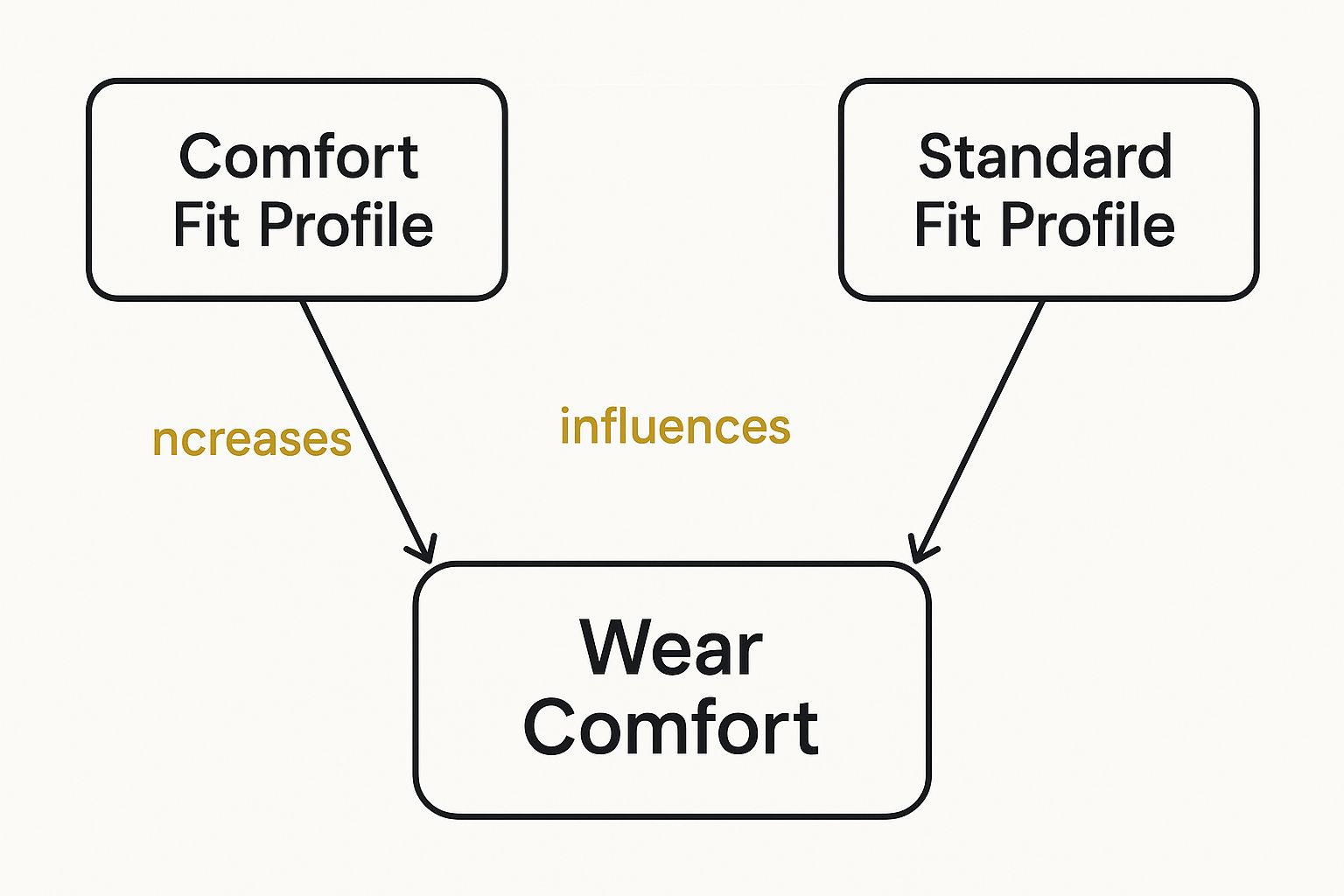
As you can see, a comfort fit profile, with its rounded interior, is designed specifically to make wider bands much more wearable for the long haul.
The shape, or profile, of the ring can subtly alter how its width is perceived. A flat band might appear wider and more modern, while a domed or court-fit band can look a bit softer and more traditional, even at the same millimeter width.
How Metal And Finish Impact A Band's Look
While the millimeter measurement is a huge piece of the puzzle, your wedding band's width is only part of its story. The final look is dramatically shaped by two other key players: the metal it’s made from and the finish applied to its surface.
Think of the metal as the canvas and the finish as the style of brushstroke—together, they create the final masterpiece.
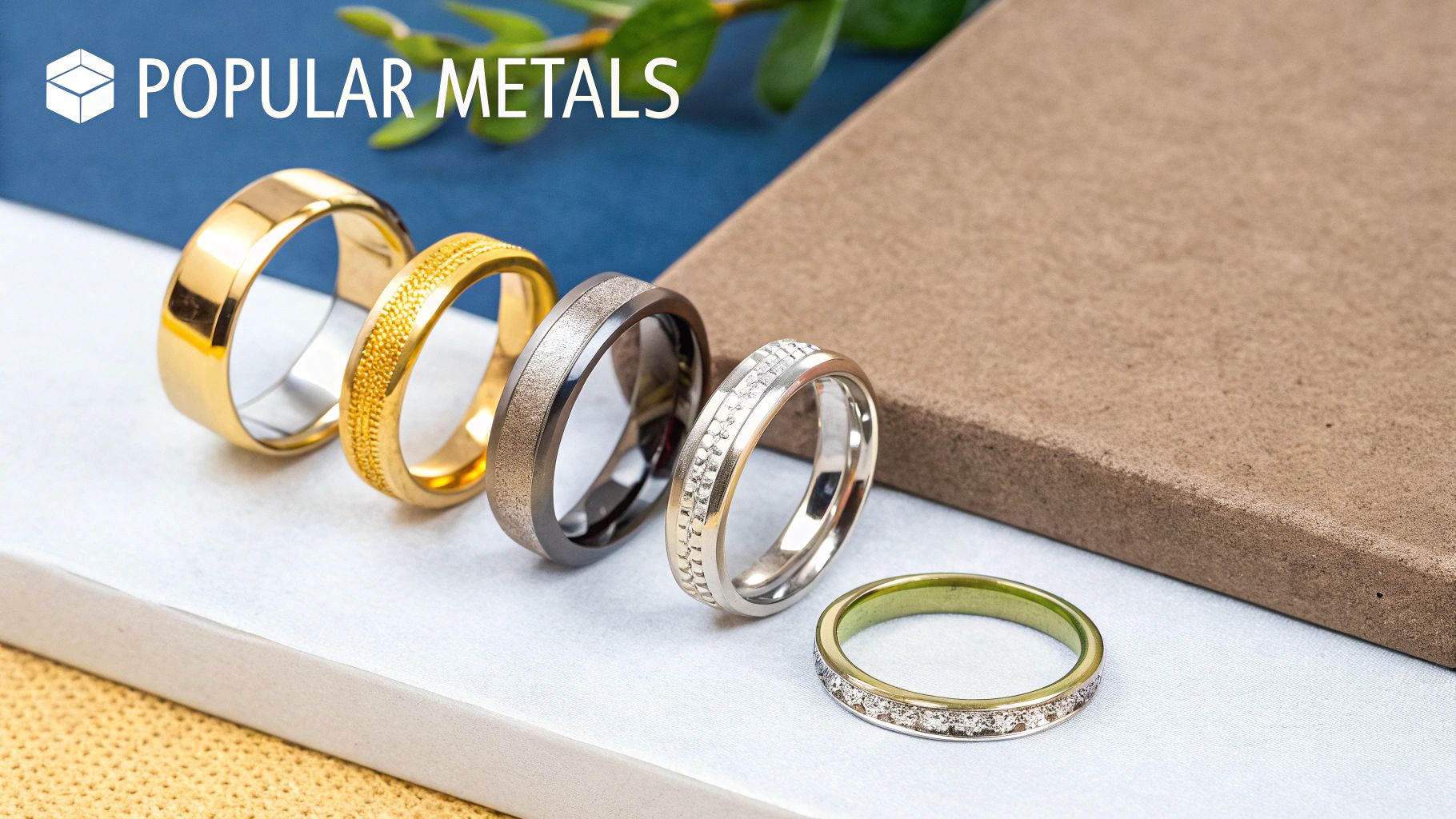
A ring’s finish acts like a filter, changing how light interacts with the metal. This simple detail can make the very same band appear bolder, softer, or more understated.
The Power Of A Polished Finish
A polished finish is that classic, mirror-like shine you see on most traditional wedding bands. This high-gloss surface reflects a ton of light, which can make the ring appear more prominent and eye-catching. On a classic yellow gold or platinum band, this bright finish makes even a narrower ring pop. The reflective quality can give the illusion of a slightly wider band simply because it draws more attention.
Understated Elegance With Matte And Brushed Finishes
If you prefer a softer, more modern look, a different finish can completely change the game. These textures absorb more light than they reflect, giving the ring a subtle, non-reflective appearance.
Here’s how they differ:
- Matte Finish: This provides a smooth, flat look with very little shine. It’s perfect for giving a wider band a more contemporary and subdued feel.
- Brushed Finish: Created by using a wire brush, this finish has a soft, textured look with fine lines. It masterfully hides minor scratches and softens the visual impact of a substantial band.
Choosing a matte or brushed finish is a fantastic strategy for anyone who loves the idea of a wider, more substantial band but prefers an understated aesthetic. It provides presence without the high shine.
How Metal Choice Changes Everything
The metal you choose also has a profound effect on the ring's visual weight. Bright, warm metals like yellow gold naturally stand out against most skin tones, making the band appear more distinct. In contrast, cooler metals like platinum or tungsten can sometimes blend more seamlessly for a sleeker look. If you need help comparing options, our guide on the best metal for wedding bands is a great resource.
The choice of metal is a huge factor in the global wedding ring market, which was valued at USD 71.4 billion in 2023. Gold has long been a dominant force, and with the market projected to grow, the variety of metals and styles available will only increase. When making decisions, it's smart to keep your overall budget in mind. For broader advice, you might find some great tips for saving money on your wedding day. Combining the right width, metal, and finish will help you find a ring that’s a perfect reflection of your style.
Common Questions About Wedding Band Width
Choosing a wedding band width can feel like a small detail, but it makes a huge difference. To help you feel completely confident in your final decision, we've gathered the most common questions we hear from couples just like you. Let’s clear up any lingering doubts with some straightforward answers from our experts.
What Is The Most Popular Wedding Band Width?
For women, the most popular widths are between 2mm and 4mm. This range pairs beautifully with most engagement rings, creating a balanced look without stealing the spotlight. A 2.5mm or 3mm band is a timeless choice.
For men, the sweet spot is typically wider, between 5mm and 7mm. A 6mm band is a true classic—it has enough substance to feel significant but isn't so bulky that it gets in the way of daily life. This width is considered the "goldilocks" choice for many hand sizes.
Should My Wedding Band Match My Engagement Ring's Width?
There's no single rule, but the goal is to create a look that feels intentional. A popular and timeless approach is to choose a wedding band that's either the same width as your engagement ring or slightly narrower. This ensures your engagement ring remains the star of the show while the wedding band acts as a beautiful complement.
That said, don't be afraid to experiment! Playing with different widths can create a unique and deeply personal stack. The best way to know for sure is to try on a few combinations to see which aesthetic speaks to you.
How Does A Comfort Fit Band Affect Width?
A comfort fit is a game-changer for wearability, especially on wider rings (6mm and up). This design features a rounded interior, which reduces the amount of metal in direct contact with your skin. While it doesn't change the external millimeter width, it dramatically improves how the ring feels by making it slide more easily over the knuckle and sit more comfortably during daily wear. We highly recommend a comfort fit for anyone choosing a more substantial band.
A comfort fit ring has a rounded interior, making it easier to slide on and off. A standard fit ring has a flat interior that can feel tighter, particularly on a wider band.
Can I Resize A Very Wide Wedding Band?
This is a critical question to ask before you buy. Resizing extra-wide bands (8mm and up) can be trickier and more expensive than resizing narrower ones. The difficulty also depends on the metal. Traditional metals like gold and platinum can usually be resized, but contemporary metals like tungsten or titanium often can't be resized at all due to their extreme hardness.
This makes getting an accurate size right from the start absolutely essential, especially if you're drawn to a wide-band style in one of these alternative metals.
If you're looking for more guidance beyond just the width, this general guide to choosing your perfect wedding ring is a fantastic resource that covers all the bases as you finalize your decision.
At Precious Pulse Jewelry, we believe finding the perfect wedding band should be an exciting and joyful part of your journey together. Explore our stunning collection of rings in every width and style to find the one that tells your unique story.

